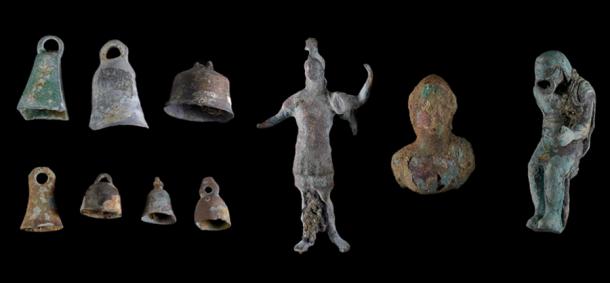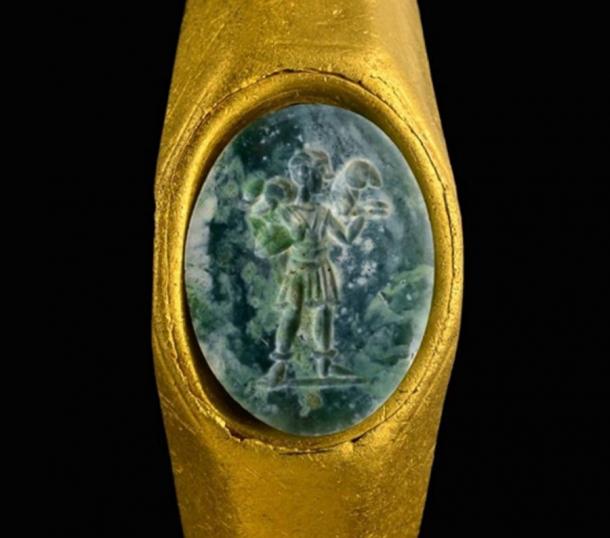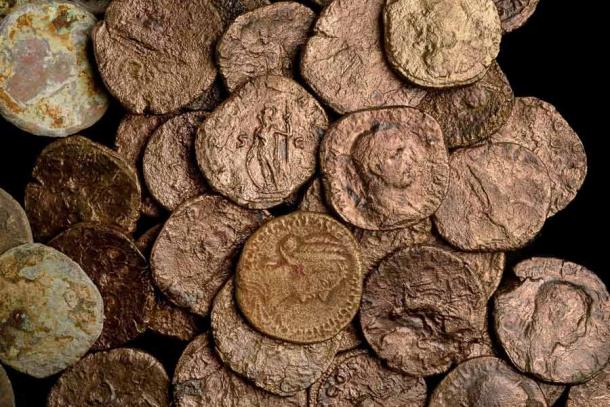Called an ‘exceptional’ find by Robert Kool, head of the authority’s coin department, the Israel Antiques Authority (IAA) announced Wednesday the discovery of remnants of two shipwrecks off the Mediterranean Coast, reports The Jerusalem Post . It has been identified as a Roman-era golden ring, with an early Christian symbol for Jesus inscribed upon its gemstone. The IAA’s Marine Archaeology Unit was carrying out a routine survey off the entire coast of Israel, and were in an area right outside of the harbor of Caesarea.
A Treasure Trove Borne Out of a Storm?
“We spotted a broken metal anchor and decided to see if there was more in the area. We soon started to find many other artifacts,” says archaeologist Jacob Sharvit.
The ring was one amongst a treasure trove of third-century Roman era artifacts, including hundreds of Roman and medieval silver coins, along with a bronze eagle figurine, bells to ward off evil spirits, pottery, and a Roman pantomimus (mime) figurine in a comic mask, as per a statement by the Israel Antiques Authority.

A selection of bells was amongst other interesting artifacts recovered from the sites. (Dafna Gazit, Israel Antiquities Authority)
According to the investigators of the Marine Archaeology Unit in the Ancient Authority, “The findings tell the story of two ships that crashed on their journeys, during different periods, probably when they tried to sail or find shelter from storms,” they write in a Facebook post . They’ve been dated to the Roman and royal period, i.e., 1700 (3rd century AD) and 600 years ago (14th century AD) respectively.
In Israeli history, the royal period is associated with the rule of the Mamluks, a dynasty of manumitted slave soldiers, a military caste and state that ruled Northeastern Africa and Western Arabia between the 13th and 16th centuries.
The scattered debris of the ship suggests to the researchers that at least one ship went down in a very powerful storm. This is explained in the statement, “Many metal parts belonging to a wooden ship body were discovered, including dozens of large bronze signs, lead pipes belonging to a water pump, and a large iron anchor, which was broken – a testimony to the power of the forces that worked on it until it was broken, apparently, in the storm.”
The ‘Good Shepherd’
“We know that similar images were found in the Christian catacombs in Rome ,” said Helena Sokolov, a curator at the IAA Coin Department, in reference to the gold ring, which generated a fair amount of curiosity amongst the investigation team.
The ring attracted the most attention, for its Biblical reference to Jesus – that of the ‘good shepherd’. Thick and octagonal, the green stone on the ring has the engraved figure of a young shepherd in a tunic and carrying a lamb on his shoulders. This image is a very early reference to Jesus, which was used multiple times in the Gospels. “I am the good shepherd,” reads a verse in John. “The good shepherd lays down his life for the sheep.”

The ring with the Christian symbolism of the ‘Good Shepherd’. ( Dafna Gazit, Israel Antiquities Authority)
“This image, of the ‘Good Shepherd’, is known in ancient Christian art as a symbol of salvation; it is a parable of Jesus as the merciful shepherd of mankind, or as the one who has shown the protection of man or the testimony of his believers,” says the Facebook post.
Rome’s Relationship With Christianity
This ties up with the spread of Christianity in the area, “This was a period when Christianity was just in its beginning, but definitely growing and developing, especially in mixed cities like Caesarea,” Sokolov told AFP. The ring was very small, indicating that it perhaps belonged to a woman, reports CBS News .
In fact, as Rome was a pagan-worshipping empire, Christians were persecuted from the 1st century onwards, and this would last for another two and a half centuries, until the reign of Constantine the Great in the 4th century AD.

Bronze coins from the Roman period recovered from the shipwreck. (Dafna Gazit / Israel Antiquities Authority)
The Roman historian Tacitus notes that Emperor Nero tried to pin the blame for the Great Fire of Rome on Christians, leading to the first official sanction of Christian persecution recorded in 64 AD. During Nero’s reign, Saint Peter and Saint Paul, the two Apostles of Christ, were also martyred – a fact that is remembered by the Catholic Church even today.
During the reign of Diocletian, things got even worse – the Great Persecution of the early 4th century saw widespread violence, and an attack on homes, books, places of worship, along with the arrest, public torture, mutilation, parading and gladiatorial contests involving Christians. Sokolov added that Christianity was being practiced in underground forums, while the empire started becoming gradually more tolerant towards emerging forms of Christian worship around Jesus.
Top image: An octagonal gold ring set with a green gemstone and carved with the ‘Good Shepherd’ figure. Source: Dafna Gazit, Israel Antiquities Authority
By Sahir Pandey
Related posts:
Views: 0
 RSS Feed
RSS Feed

















 December 24th, 2021
December 24th, 2021  Awake Goy
Awake Goy  Posted in
Posted in  Tags:
Tags: 
















